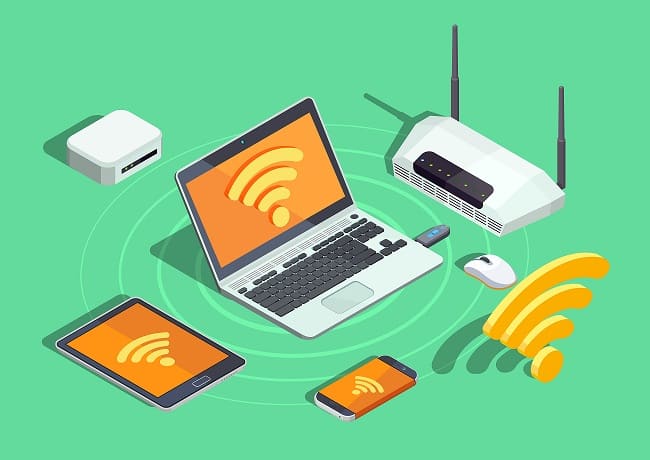
The terms “WiFi” and “wireless” are often confused when referring to Internet connectivity. Basically these words are synonymous with one another and mean Internet connectivity without wires. WiFi stands for Wireless Fidelity and is used to create a wireless Local Area Network or WLAN that allows PCs to transmit data to one another without the use of cables.
So what exactly is WiFi and wireless Internet and how does it work?
WiFi Defined
WiFi works via radio waves and is a form of two-way radio communication similar to a ham or CB radio. The communication is similar to cell phones since you can send and receive voice and data in a reciprocal form of communication.
WiFi Internet has a relatively simple configuration which consists of a wireless adapter that is connected to your PC. This allows for data conversion to a radio signal which is transmitted via an antenna. A wireless router is added to the configuration to act as a decoder as it forwards the data to the Internet. If someone is sending data to your computer over the Internet the configuration works in reverse.
WiFi and IEEE Standards
WiFi and wireless Internet is commonly referred to as 802.11 which is a standard that is set forth by IEEE or Institute of Electrical and Electronics Engineers and one of the largest technical professional organizations worldwide. IEEE sets the standards for wireless technology and publishes a high percentage of the literature with respect to electrical engineering, computer science, and electronics.
The 802.11 standard which sets different protocols for wireless networking such as 802.11g and 802.11n defines the wireless connection in terms of speed for data transmission. The most popular current standards are g and n with 802.11n being the newest IEEE standard which defines data transmission at speeds of up to 140 megabits per second. This is to accommodate the newer applications such as VoIP and video that require faster data transmission rates in order to function efficiently.
802.11g is still being used and has data transmission rates of 54 megabits per second (Mbps). This is not as fast as 802.11n but still is able to handle some of the more recent applications. The predecessors of these two standards are 802.11a and 802.11b which are not as fast in terms of data transmission since they are earlier standards that were established prior to modern applications such as VoIP and video.
Component Checklist for WiFi and Wireless Internet Connectivity
If you are setting up a WiFi connection in your home or for your business the setup requires common components that make up the infrastructure for the wireless network. If you have more than one computer in your home or business then the main component you will need is a wireless router to convert the signals for data transmission. If you are trying to establish a public access point in your business then you will be simply setting up the configuration to allow other wireless-enabled devices used by your patrons to connect to the Internet. That said here are the basic components you need to setup a wireless network.
- Wireless Router: Companies such LinkSys and others make quality wireless routers that can handle more than one IEEE standard. As a general rule the most recent standards of 802.11g and 802.11n are used when you implement a router into the configuration. The standard coverage for a wireless access point is about 100 feet. If you are installing the network in a large facility it may require a wireless repeater antenna to extend the signal.
- Cable or DSL Modem: The modem is the device responsible for establishing a connection to the Internet. It is typically provided by your cable or DSL Internet Service Provider and acts as the mediator between your PC and your Internet connection. The modem utilizes your telephone lines to access the Internet with an “always on” connection that does not interfere with your telephone service.
- Ethernet Cables: The Ethernet cables help you to setup the connection between the modem, wireless router, and your PC. These are blue cables that have a connection on either end that resembles a telephone connection. To setup a wireless network you will need two of these cables.
- PCI Wireless Card: If your PC is not already equipped for wireless it will be necessary to purchase a PCI card to install in your PC to make it wireless-enabled. A PCI card can be purchased at any electronics or computer retail outlet.
- Installation Software: The modem and the wireless router require installation software for configuration. The modem software is typically installed from a disk that accompanies your modem. The router is generally configured from a web interface with a URL address that is included in the instruction manual.
If you are establishing a public or municipal WiFi connection then you will simply use one hub that connects to the Internet and supplies the connection for multiple users. The hub or wireless access point is made available to users with WiFi enabled mobile devices that automatically find the connection once you have set it up. You supply the connection while the end user worries about making their device wireless-enabled.